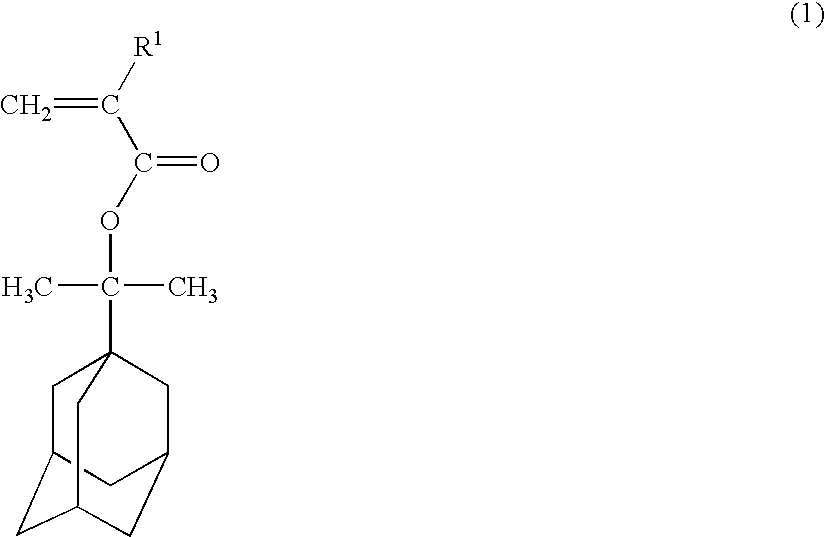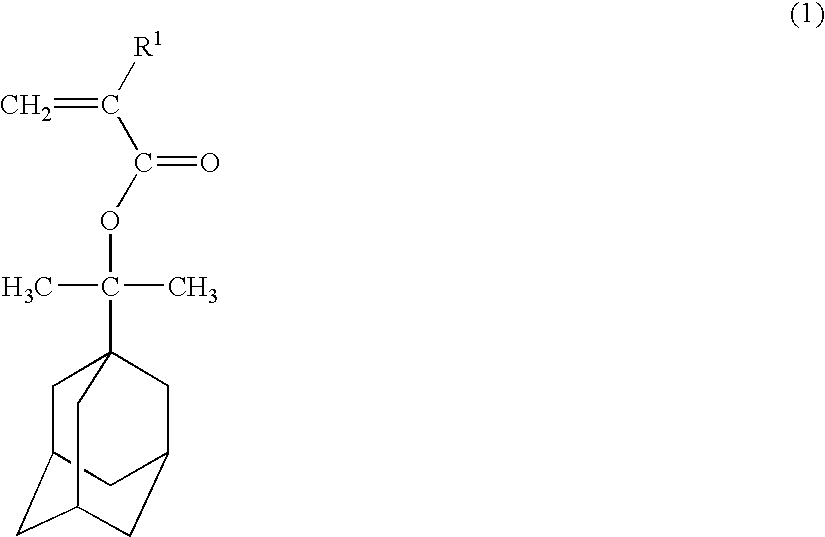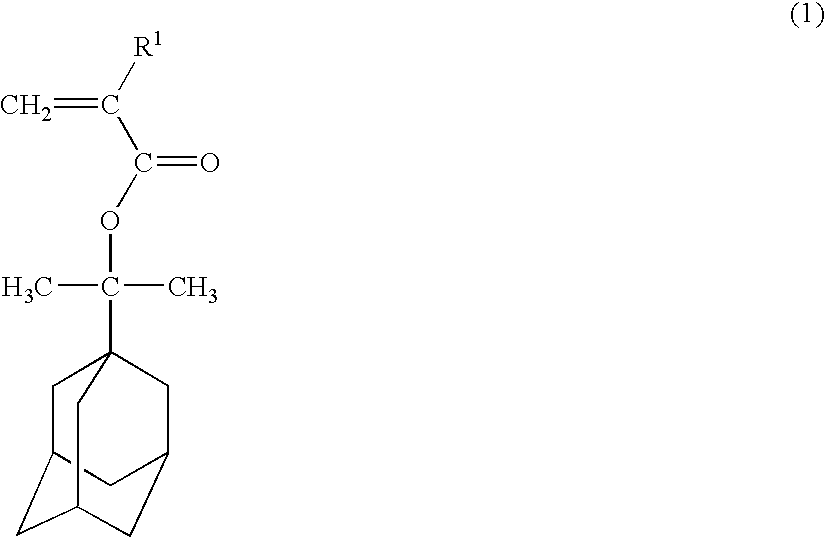Polymerizable adamantane derivative, production process thereof and polymeric compound
- Summary
- Abstract
- Description
- Claims
- Application Information
AI Technical Summary
Benefits of technology
Problems solved by technology
Method used
Image
Examples
production example 1
[0054] To a three-necked flask equipped with a thermometer, 11.6 g (0.1 mol) of 1,4-cyclohexanediol, 12.1 g (0.12 mol) of triethylamine and 200 ml of tetrahydrofuran were added, and was stirred under nitrogen gas stream while cooling on ice. To the mixture 19.0 g (0.12 mol) of 2-trifluoromethyl acrylic acid chloride was added, and was stirred for 2 hours at room temperature. After the reaction the mixture was concentrated under reduced pressure, 300 ml of pure water was added to the concentrated residue and extracted twice with 300 ml of ethylacetate. The organic layers were united, washed with 300 ml of 5 weight % sodium bicarbonate aqueous solution and 300 ml of 10 weight % salt aqueous solution, respectively, dried by magnesium sulfate, and concentrated under reduced pressure. By purifying the concentrated residue by silica gel column chromatography 13.8 g (0.058 mol) of 2-trifluoromethylacrylic acid 4-hydroxycyclohexyl [=1-(2-trifluoromethyl-2-propenoyloxy)-4-hydroxycyclohexane]...
example 1
[0057] A three-necked flask equipped with a thermometer, a Dimroth condenser and a inlet of nitrogen was fulfilled by nitrogen and 73 ml of 3M methyl magnesium chloride-tetrahydrofuran solution was placed in it. While the solution was stirred at room temperature, a solution of 20 g of 1-adamantane carbonyl chloride dissolved in 25 ml of toluene was dropped over 30 minutes. After dropping, the reaction mixture was stirred for 2 hours while heating and refluxing. After cooling the reaction mixture until room temperature, 20.6 g of 2-trifluoromethyl acryl acid chloride was dropped in for one hour. After dropping, the reaction mixture was stirred for 2 hours while heating and refluxing. After standing to cool the reaction mixture until room temperature, 100 ml of water and 100 ml of ethyl acetate were added, the organic layer was separated, dried by magnesium sulfate and then concentrated under reduced pressure. By subjecting the concentrated residue to silicagel chromatography, 18.3 g ...
example 2
[0059] To a three-necked flask equipped with a thermometer, 19.4 g (0.1 mol) of 1-(1-adamantyl)-1-methylethanol, 30.3 g (0.3 mol) of triethylamine and 200 ml of tetrahydrofuran were placed and stirred while cooling under nitrogen gases. In this mixed solution 22.9 g (0.14 mol) of 2-trifluoromethyl acrylic acid chloride was added and stirred for 2 hours at room temperature. After the reaction, 500 ml of pure water was added, tetrahydrofuran and triethylamine were distilled off under reduced pressure, and 1 L of ethyl acetate was added to perform extraction. The organic layer was washed with 500 ml of 5% by weight sodium hydrogencarbonate aqueous solution and 500 ml of 10% by weight salt aqueous solution separately, dried by magnesium sulfate and then concentrated under reduced pressure. By subjecting the concentrated residue to silicagel chromatography, 28 g (0.089 mol) of 1-[1-(2-trifluoromethyl-2-propenoyloxy)-1-methylethyl]adamantane represented by the formula (10) was obtained. T...
PUM
| Property | Measurement | Unit |
|---|---|---|
| Hydrophilicity | aaaaa | aaaaa |
Abstract
Description
Claims
Application Information
 Login to View More
Login to View More - R&D
- Intellectual Property
- Life Sciences
- Materials
- Tech Scout
- Unparalleled Data Quality
- Higher Quality Content
- 60% Fewer Hallucinations
Browse by: Latest US Patents, China's latest patents, Technical Efficacy Thesaurus, Application Domain, Technology Topic, Popular Technical Reports.
© 2025 PatSnap. All rights reserved.Legal|Privacy policy|Modern Slavery Act Transparency Statement|Sitemap|About US| Contact US: help@patsnap.com



